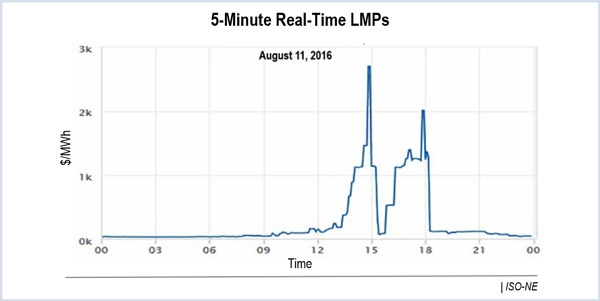By William Opalka
FERC on Thursday granted a complaint by New England generators that a penalty imposed during a summer heat wave proved that a rule intended to punish resource withholding is unjust and unreasonable (EL16-120).
The commission agreed with the New England Power Generators Association that the peak energy rent adjustment should be raised. (See Generators: ‘Unjust’ Rule Cost $100M in New England Heat Wave.) But it ordered that the amount of increase should be determined in an evidentiary proceeding if stakeholders cannot reach a settlement.
“NEPGA has demonstrated that, as a result of the new reserve constraint penalty factors, the relationship between the amount of compensation that suppliers receive for energy in scarcity periods, and the amount that suppliers must rebate as a result of the operation of the PER mechanism, has rendered the existing PER mechanism unjust and unreasonable,” the commission wrote.
“We agree with NEPGA that for the time period in question, capacity resources were unable to anticipate a future increase in reserve constraint penalty factors and, accordingly, were unable to reflect a corresponding increase in their capacity offers.
“We additionally find that, as NEPGA has suggested, this problem can be remedied by raising the PER strike price. Doing so would return the PER rebate to an amount that more closely reflects the expectations of the parties at the time of the seventh and eighth Forward Capacity Auctions in February 2013 and 2014, respectively, the commission wrote. The higher penalty factors were ordered by the commission in May 2014.
NEPGA said the adjustment created “absurd” results during a six-hour period of intense heat on Aug. 11 that featured unexpected outages and high prices.
The PER adjustment reduces capacity suppliers’ monthly capacity payments by an amount that approximates the “peak energy rents” earned by a hypothetical generator in the real-time energy market.
When the hourly real-time energy market price exceeds a predetermined “strike price,” the RTO calculates an “hourly PER” value that roughly equals the difference between the real-time clearing price and the strike price. These monthly values are added for the month, averaged over a rolling 12-month period and then deducted from suppliers’ monthly capacity payments.
NEPGA requested that the PER strike price be increased by $250/MWh, the same change ISO-NE proposed to stakeholders in 2014. “We note that, while ISO-NE may have found this to be a reasonable increase previously, recent market developments may justify a different increase,” the commission wrote.
FERC last year approved a Tariff change submitted by ISO-NE that eliminates the PER adjustment on June 1, 2018, at the start of the ninth capacity commitment period. The RTO said reforms in the day-ahead energy market and the Pay-for-Performance program that starts on the date have made the rule unnecessary.




